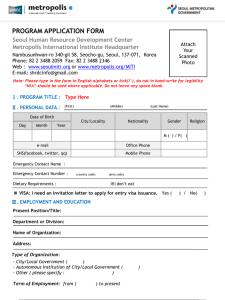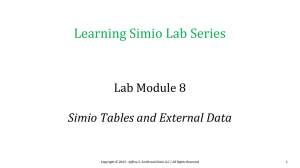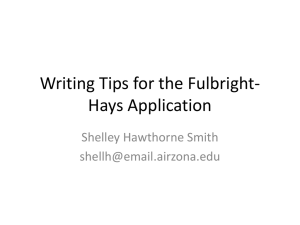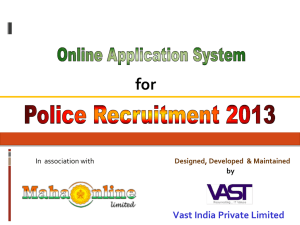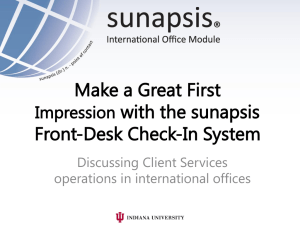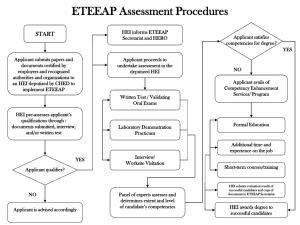Simio Lab: Driver's License Facility Simulation
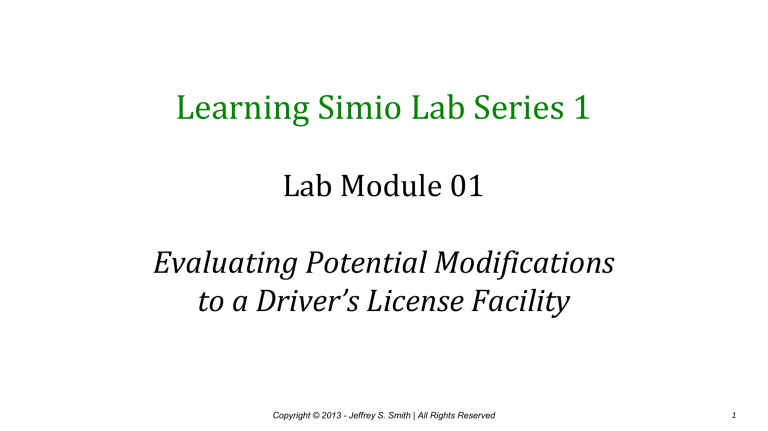
Learning Simio Lab Series 1
Lab Module 01
Evaluating Potential Modifications to a Driver’s License Facility
Copyright © 2013 - Jeffrey S. Smith | All Rights Reserved 1
Objectives and Outline
• Objectives
– Learn the basics of:
• The Simio user-interface
• Modeling in Simio
• Using the Simio Pivot Grid
• Outline
1.
Description of the system to be modeled
2.
Introduction to the Simio user interface
3.
Model the “current” configuration
4.
Experiment and verify the current model
5.
Model the “proposed” configuration
6.
In-lab and take-home assignments
Video 1
Video 2
Video 3
Video 4
Video 5
Copyright © 2013 - Jeffrey S. Smith | All Rights Reserved 2
Applicants arrive at a rate of approximately
10/hour.
Performance Metrics:
• Server Utilizations
• Time In System
• Number In System
Drivers’ License Office
Check In
Written
Exam
At check-in, a single clerk checks the applicant’s
The written exam is administered by one of two exam clerks.
When an applicant driving history
(if any) and gives the applicant the initial paperwork.
arrives, s/he waits for an available clerk and, once one is available, takes the exam with the clerk.
Check-in takes approximately 5 minutes.
The exam requires approximately 8.8 minutes.
Copyright © 2013 - Jeffrey S. Smith | All Rights Reserved
Check Out
At check-out, the applicant completes the process using one of two check-out computers and receives his/her temporary license.
Check-out takes approximately 9 minutes.
3
• Files Menu
• Ribbons
• Project Tabs
• Libraries
• Project
• Current Model
• Properties
• Facility View
Simio User Interface
Copyright © 2013 - Jeffrey S. Smith | All Rights Reserved 4
Simio Standard Library
Source : Generate entities of a specified type and arrival pattern.
Sink : Destroy entities.
Server : Capacitated process, such as a machine.
Workstation : Capacitated process, includes setup, process, tear-down.
Combiner : Batches entities with a parent entity (e.g., pallet).
Separator : Splits batches or copies entities.
Resource : Seized/Released by objects.
Vehicle : Fixed route or on-demand pickups/drop-offs.
Worker : Moveable resource, for stationary and non-stationary tasks.
BasicNode : Simple intersection, fixed object input.
TransferNode : Change destination/get rides, fixed object output.
Connector : Zero travel time.
Path : Entities independently move at their own speeds.
TimePath : Entities complete travel in a specified time.
Conveyor : Accumulating/non-accumulating conveyor devices.
Copyright © 2013 - Jeffrey S. Smith | All Rights Reserved 5
Applicants arrive at a rate of approximately
10/hour.
Performance Metrics:
• Server Utilizations
• Time In System
• Number In System
Drivers’ License Office
Check In
Written
Exam
At check-in, a single clerk checks the applicant’s
The written exam is administered by one of two exam clerks.
When an applicant driving history
(if any) and gives the applicant the initial paperwork.
arrives, s/he waits for an available clerk and, once one is available, takes the exam with the clerk.
Check-in takes approximately 5 minutes.
The exam requires approximately 8.8 minutes.
Copyright © 2013 - Jeffrey S. Smith | All Rights Reserved
Check Out
At check-out, the applicant completes the process using one of two check-out computers and receives his/her temporary license.
Check-out takes approximately 9 minutes.
6
• So, we need to model:
– Applicant arrival process
Drivers’ License Office
Source
– Check-in process
– Exam process
– Check-out process
– Applicant departure process
– Applicant transfer between processes
Server
Server
Server
Sink
Path
Copyright © 2013 - Jeffrey S. Smith | All Rights Reserved 7
Build the Initial Model!
Copyright © 2013 - Jeffrey S. Smith | All Rights Reserved 8
Object Hierarchy - The Family of “Objects”
Object Runspace
( Realization )
Object Instance
Object
Definition
Copyright © 2013 - Jeffrey S. Smith | All Rights Reserved 9
Initial Object Properties
• Source1 (Source)
– Interarrival Time: Random.Exponential(6) ; units: Minutes
• CheckIn (Server)
– Initial Capacity: 1 (default)
– Processing Time: Random.Exponential(5) ; units: Minutes
• Exam (Server)
– Initial Capacity: 2
– Processing Time: Random.Exponential(8.8) ; units: Minutes
• CheckOut (Server)
– Initial Capacity: 2
– Processing Time: Random.Exponential(9) ; units: Minutes
• Sink1 (Sink)
– All defaults
Copyright © 2013 - Jeffrey S. Smith | All Rights Reserved 10
Editing Properties
• Displayed in Properties Window
• Defined by object builder
• Integers, Booleans, rules, expressions, …
• Expression editor (down arrow at right):
Copyright © 2013 - Jeffrey S. Smith | All Rights Reserved 11
Applicants arrive at a rate of approximately
10/hour.
Performance Metrics:
• Server Utilizations
• Time In System
• Number In System
Drivers’ License Office
Check In
Written
Exam
At check-in, a single clerk checks the applicant’s
The written exam is administered by one of two exam clerks.
When an applicant driving history
(if any) and gives the applicant the initial paperwork.
arrives, s/he waits for an available clerk and, once one is available, takes the exam with the clerk.
Check-in takes approximately 5 minutes.
The exam requires approximately 8.8 minutes.
Copyright © 2013 - Jeffrey S. Smith | All Rights Reserved
Check Out
At check-out, the applicant completes the process using one of two check-out computers and receives his/her temporary license.
Check-out takes approximately 9 minutes.
12
Run Length and Pivot Grid
Copyright © 2013 - Jeffrey S. Smith | All Rights Reserved 13
Expected “Results” – Static Model
Arrival Rate (per hr)
IAT (mins)
10
6
Split
Capacity
Process Time (mins)
Process Rate (per hr per unit)
Utilization
Num at Station (L)
Time at Station (W - mins)
Check-in Exam Check-out Overall
100.0% 100.0% 100.0%
1 2 2
22.8
5
12.0
83.3%
5
30
8.8
6.8
73.3%
3.2
19.2
9
6.7
75.0%
3.4
20.4
11.6
69.6
Copyright © 2013 - Jeffrey S. Smith | All Rights Reserved 14
Applicants arrive at a rate of approximately
10/hour.
Performance Metrics:
• Server Utilizations
• Time In System
• Number In System
Drivers’ License Office
Check In
Written
Exam
At check-in, a single clerk checks the applicant’s
The written exam is administered by one of two exam clerks.
When an applicant driving history
(if any) and gives the applicant the initial paperwork.
arrives, s/he waits for an available clerk and, once one is available, takes the exam with the clerk.
Check-in takes approximately 5 minutes.
The exam requires approximately 8.8 minutes.
Copyright © 2013 - Jeffrey S. Smith | All Rights Reserved
Check Out
At check-out, the applicant completes the process using one of two check-out computers and receives his/her temporary license.
Check-out takes approximately 9 minutes.
15
Proposed System Modification
Check In
Written
Exam
Add an optional “computerized exam kiosk” to replace one of the two clerks.
Applicants would have a choice between the exam administered by a human clerk and the computerized exam.
The computer kiosk will support two exam-takers at a time.
Initially, assume that ½ of the applicants choose the kiosk and that the exam time is the same as with the human clerk.
Copyright © 2013 - Jeffrey S. Smith | All Rights Reserved
Check Out
16
Build the Proposed Configuration Model!
Copyright © 2013 - Jeffrey S. Smith | All Rights Reserved 17
In-Lab Assignment
Server Utilizations
Ck-In M-Exam C-Exam Ck-Out NIS TIS
Current
Proposed A
Proposed B
Proposed C
• Proposed A - Exponential exam times for both
• Proposed B – Reduced variance on the exam times:
• Human – Random.Triangular(6, 8.8, 11.6)
• Kiosk – Random.Uniform(6, 11.6)
• Proposed C – Same as B, but send 70% to the kiosk (hint: use Selection
Weights on the alternative paths leading from check-in)
• For each metric, report the average and confidence interval half-width (h) based on 25 replications, each of length 1000 hours with a 500 hour warm-up.
Copyright © 2013 - Jeffrey S. Smith | All Rights Reserved 18
Homework Assignment
• Starting with the “Proposed C” configuration from the in-lab assignment, implement the following exam failure logic:
– When an applicant fails the exam, s/he returns to re-take the exam. The applicant should return to the same exam station (either human or computer)
• Using your modified model, determine the maximum percentage of exam failures that the system can support before becoming unstable
(where the exam servers cannot keep up with the arriving applicants).
• Consider a walk-up bank that that has an ATM, a single teller, and a manager.
• ATM customers visit the ATM and teller customers visit the teller.
• 10% of customers (regardless of original type) visit the manager after visiting the ATM or teller.
• Arrival and service time properties are:
– ATM customers arrive at the rate of 10/hour and spend approximately 4 minutes at the ATM
– Teller customers arrive at the rate of 5/hour and spend approximately 7 minute at the teller
– Customers that visit the manager spend approximately 20 minutes with the manager
• Run 25 replications for 2000 hours each (no warmup) and determine the server utilizations and the times that the customers spend in the system (ATM customers, teller customers, customers that see the manager)
Copyright © 2013 - Jeffrey S. Smith | All Rights Reserved 19

